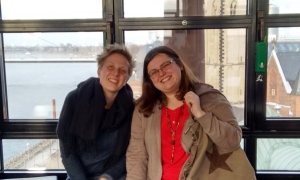Last week, my desire to visit a museum exhibition in Germany to which I had contributed came to fruition. And what a wonderful visit it was!
Off the beaten tourist path, in the northwestern German state of North Rhine-Westfalia (NRW), is a lovely museum that lifts up the history of the Upper Silesian people, a people with a strong tie to this region. When King Frederick the Great took control of Silesia in the 1700s, an area that includes a piece of northern Czech Republic and southern Poland, he invited coal miners from the NRW area to come and help develop the rich resources of Silesia. Much cross fertilization took place between these two areas. So when Silesians of German heritage were forced from their homes following World War II, it was to the NRW that many of them fled. Some thirty years later, many of these Upper Silesians began to pool together documents and artifacts of their history, and the Oberschlesiches Landesmuseum, now run by the NRW state, is the result.

Panels showing the assistance of UNRRA, the seagoing cowboys, and the Heifer Project to Silesia following World War II. Photo: Peggy Reiff Miller
Since December 6, 2015, the museum has been featuring an exhibition titled “For Body and Soul: the Culture of Food and Drink.” The museum ends with a display focusing on “Food in Times of Crisis,” and it is to this portion of the exhibition that I have contributed materials. When the exhibit was extended to February 19 of this year, I grabbed the opportunity to travel to Germany and see it for myself.

Curator Melanie Mehring describes the difficulties of food in times of flooding and war. Photo: Eliska Hegenscheidt-Nozdrovicka
As with most of Europe, Upper Silesia bore the impact of World War II. With the loss of farm animals and crops, feeding the populace became a challenge. The United Nations Relief and Rehabilitation Administration came to the aid of Czechoslovakia and Poland, delivering not only livestock, but staple goods, as well. Two of the UNRRA shipments to Czechoslovakia included Heifer Project animals to be given to the neediest of farmers, and some of these animals were placed in Silesia. When the museum curator did an internet search on “UNRRA,” she found my website and contacted me to see if I might have materials to share with them. I pulled together what I had, and Heifer International gave permission for the use of some of their materials, as well. What a joy to see the beautifully assembled display in person!

Michael Ullrich reads the letter of thanks from the Gallus family of Silesia for their heifer from the Heifer Project. Photo: Peggy Reiff Miller
The exhibit features the loading of the animals in the United States, the care of the animals by the seagoing cowboys on the journey across the Atlantic, and the arrival of the seagoing cowboys in the devastated port cities of Nowy Port, Poland, and Bremen, Germany. From Bremen, the animals were shipped overland to Czechoslovakia and distributed to farmers selected by local committees. A thank you letter from a Silesian family who lost all their buildings and animals highlights the significance of these gifts of heifers. The letter ends:
Dear friends from America, we thank you for all you have done and still want to do for us in our war-torn Silesia. Especially, my family and I thank you for the rich gift of my only heifer, which brings us great joy. You have done a good deed that not only we, but also our children, will long hold in our memory.
Accompanying me to the museum was Michael Ullrich of Bremen, Germany, whom Heifer International has contracted to write a booklet about the shipments of the Heifer Project to Germany in the 1950s. The heifers were given mainly to people of farm background who had been expelled from Eastern European countries after the war. Mr. Ullrich is interviewing as many of them as he can find, and I’m looking forward to his book! Many resettled Silesians were among the Heifer Project recipients, some of whom I met and interviewed in 2013. This museum visit brought the story full circle for me – “food for body and soul” for me, as well.

Melanie Mehring and Eliska Hegenscheidt-Nozdrovicka gave me a delightful tour around Düsseldorf, capital of NRW, on my arrival. Photo: Peggy Reiff Miller
Immense thanks to the two lovely young women who facilitated our visit: museum education director Eliska Hegenscheidt-Nozdrovicka and museum curator Melanie Mehring! Your passion for your work shines through! May we meet again!



I am traveling to Germany this December, 2017 and have just been informed of this exhib. My father was part of this and sent heifers to Germany after WW !!…Heifer Project is “in my blood” and am hoping this exhibit is still in existence. Would welcome any infor on this. Would live to visit and see. Thank you.
Anne Glenn-White, Decorah, IA
LikeLike
Thanks for your interest, Anne. Unfortunately, the exhibit ended in February. Best wishes for your trip to Germany!
LikeLike
You are an amazing representative for Heifer. Thank you. Bill
Sent from my iPhone
>
LikeLiked by 1 person
Thanks, Bill!
LikeLike
Such a heartwarming story. It is awe-inspiring to hear such stories and knowing that what my parents did 1944-1948 made such a impact globally for those in such dire need after WWII.
LikeLiked by 1 person
Yes, it’s a heartwarming history, to be sure!
LikeLike